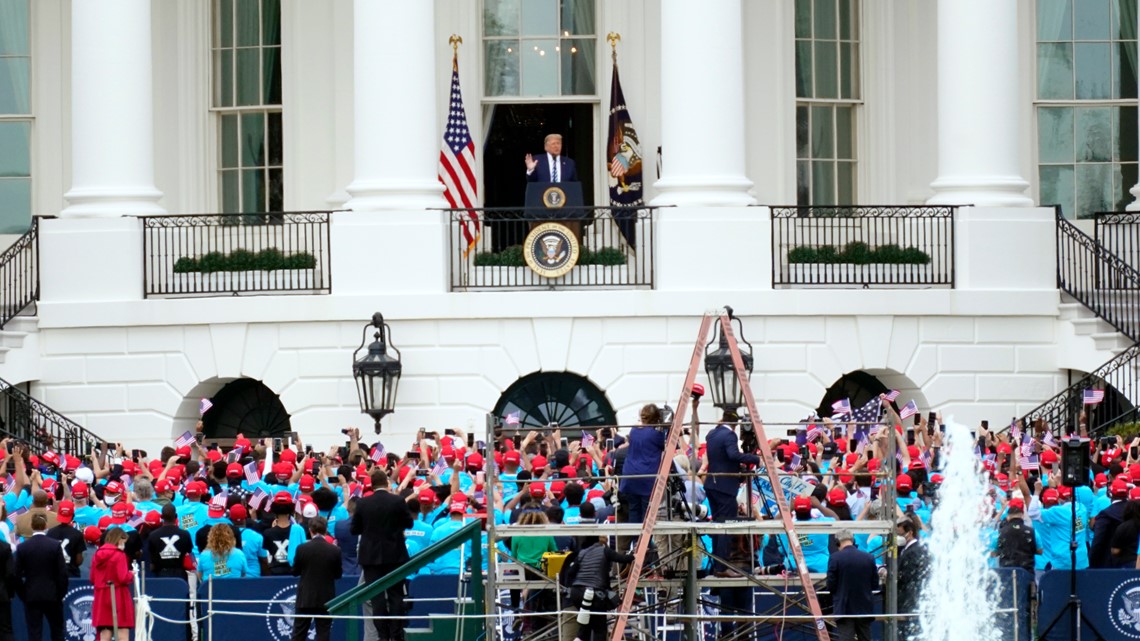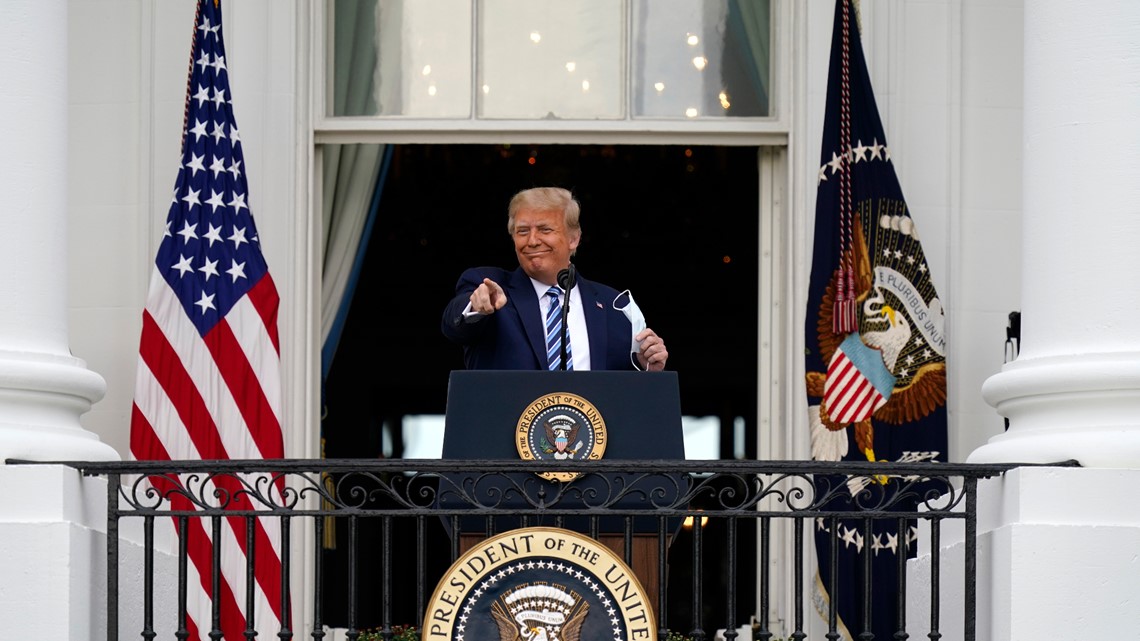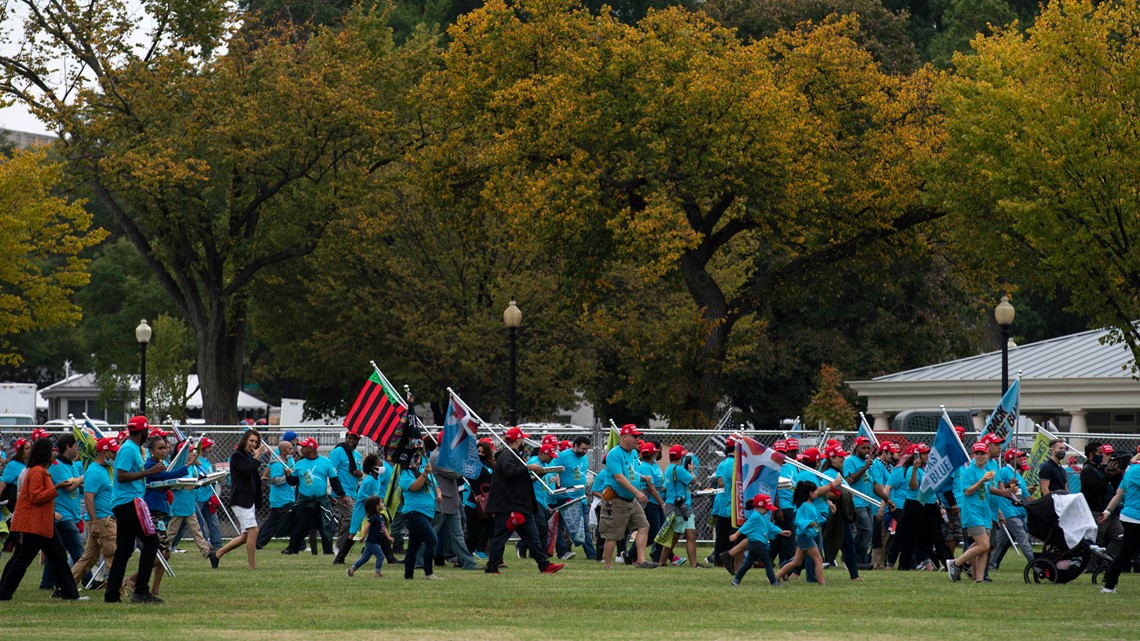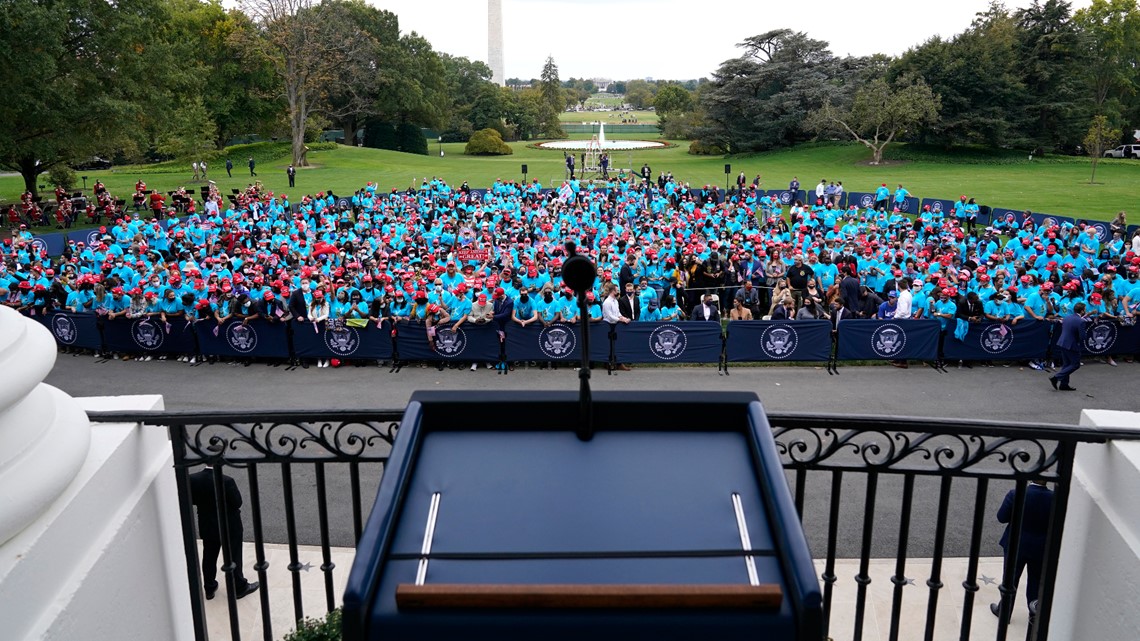WASHINGTON, D.C., USA — The White House doctor said Saturday night that President Donald Trump was no longer at risk of transmitting the coronavirus but did not say explicitly whether Trump had tested negative for it. The diagnosis came as the president prepared to resume campaign rallies and other activities.
In a memo released by the White House, Navy Cmdr. Dr. Sean Conley said Trump met the Centers for Disease Control and Prevention criteria for safely discontinuing isolation and that by “currently recognized standards” he was no longer considered a transmission risk.
The memo did not declare Trump had tested negative for the virus. But sensitive lab tests — like the PCR test cited in the doctor’s statements — detect virus in swab samples taken from the nose and throat. Dr. William Morice, who oversees laboratories at the Mayo Clinic, said earlier this week that using the PCR tests, the president’s medical team could hypothetically measure and track the amount of virus in samples over time and watch the viral load go down.
Some medical experts had been skeptical that Trump could be declared free of the risk of transmitting the virus so early in the course of his illness. Just 10 days since an initial diagnosis of infection, there was no way to know for certain that someone was no longer contagious, they said.
Dr. Albert Ko, an infectious disease specialist and department chairman at the Yale School of Public Health, said Saturday night that the White House appeared to be following CDC guidelines for when it is appropriate to end isolation after mild to moderate cases of COVID-19.
But Ko cautioned that those who have had severe cases of the diseases should isolate for 20 days. He noted that Trump was treated with the steroid dexamethasone, which is normally reserved for patients with severe COVID.
Ko added that White House had issued “convoluted” statements about Trump’s health that left many questions unanswered, including whether the president ever had pneumonia.


CDC guidelines note that most people do not require testing to decide when they can be around others. Ko said people who have had COVID-19 can continue to test positive for weeks or longer after they are no longer infectious.
The memo stated that Trump had reached day 10 from the onset of symptoms, had been free of fever for well over 24 hours, and that all symptoms had improved.
Saskia Popescu, an infectious disease epidemiologist at George Mason University, said the tight time frame laid out by the White House made it appear that “they’re really just pushing to get him out of isolation” and back to campaigning.
The memo followed Trump’s first public appearance since returning to the White House after being treated for the coronavirus at a military hospital. Hundreds of people gathered Saturday afternoon on the South Lawn for a Trump address on his support for law enforcement from a White House balcony.
Trump took off a mask moments after he emerged on the balcony to address the crowd on the lawn below, his first step back onto the public stage with just more than three weeks to go until Election Day. He flouted, once more, the safety recommendations of his own government just days after acknowledging that he was on the brink of “bad things" from the virus and claiming that his bout with the illness brought him a better understanding of it.
His return was a brief one. With bandages visible on his hands, likely from an intravenous injection, Trump spoke for 18 minutes, far less than his normal hour-plus rallies. He appeared healthy, if perhaps a little hoarse, as he delivered what was, for all intents and purposes, a short version of his campaign speech despite the executive mansion setting.


Though the gathering was billed as an official event, Trump offered no policy proposals and instead delivered the usual attacks on Democrat Joe Biden while praising law enforcement to supporters, most of whom wore masks while few adhered to social distancing guidelines.
“I’m feeling great,” said Trump, who said he was thankful for their good wishes and prayers as he recovered. He then declared that the pandemic, which has killed more than 210,000 Americans, was “disappearing” even though he is still recovering from the virus.
In either an act of defiance or simply tempting fate, officials organized the crowd just steps from the Rose Garden, where exactly two weeks ago the president held another large gathering to formally announce his nomination of Judge Amy Coney Barrett to the Supreme Court. That event is now being eyed as a possible COVID-19 superspreader as more than two dozen people in attendance have contracted the virus.


Trump had hoped to hold campaign rallies this weekend but settled for the White House event. But even as his health remained unclear, he planned to ramp up his travel with a rally in Florida on Monday, followed by trips to Pennsylvania and Iowa on subsequent days.
Security was stepped up around the White House before the event, which was called a “peaceful protest for law & order” and predominantly attended by Black and Latino supporters. Police and the Secret Service closed surrounding streets to vehicles and shut down Lafayette Square, the park near the White House that has long been a gathering place for public protest.
As questions linger about his health — and Democratic opponent Joe Biden steps up his own campaigning — Trump has more frequently called into radio and TV programs to speak with conservative interviewers, hoping to make up for lost time.


Biden's campaign said he again tested negative on Saturday for COVID-19. Biden was potentially exposed to the coronavirus during his Sept. 29 debate with Trump, who announced his positive diagnosis barely 48 hours after the debate.
The president had not been seen in public — other than in White House-produced videos — since his return five days ago from Walter Reed National Military Medical Center, where he received experimental treatments for the coronavirus.
On Saturday, all attendees were required to bring masks or were provided with them, and were given temperature checks and asked to fill out a brief questionnaire. Some in the crowd removed their mask to listen to Trump.
Trump's Monday event in Sanford, Florida, what he's described as a “BIG RALLY," was originally scheduled to be held on Oct. 2, the day after he tested positive. Ahead of his Saturday event, Trump used Twitter to share news articles about problems with mail-in ballots in New Jersey, Ohio and Texas. Trump has repeatedly made unsubstantiated claims that universal mail-in voting is beset by widespread fraud.
Trump's return to public activity came as Dr. Anthony Fauci, the government’s top infectious-disease expert, cautioned the White House again to avoid large-scale gatherings of people without masks.
Fauci said of the Barrett event in an interview with The Associated Press, “I was not surprised to see a superspreader event given the circumstances." That means “crowded, congregate setting, not wearing masks. It is not surprising to see an outbreak," he said.
District of Columbia virus restrictions prohibit outdoor gatherings larger than 50 people, although that rule has not been strictly enforced. Masks are mandatory outdoors for most people, but the regulations don’t apply on federal land, and the Trump White House has openly flouted them for months.
Confined to the White House as he recovers, Trump spent sizable chunks of the past few days making the rounds of friendly conservative media, calling in to Fox News host Sean Hannity on Thursday night and spending two hours live on air with radio host Rush Limbaugh on Friday in what his campaign billed as a “radio rally.”
Holding court on his reelection battle, his fight against the coronavirus and revived negotiations with Democrats to pass an economic stimulus bill, Trump made a direct appeal to his base of loyal supporters, whom he needs to turn out to the polls in droves.
In a Friday night interview on Fox's Tucker Carlson's show, Trump was asked if he has been retested for COVID-19. “I have been retested, and I haven’t even found out numbers or anything yet. But I've been retested, and I know I’m at either the bottom of the scale or free," he said.
White House officials, however, have declined to answer when Trump last tested negative for the virus before his diagnosis or release detailed information about lung scans taken while Trump was hospitalized.
While reports of reinfection in COVID-19 victims are rare, the CDC recommends that even people who recover from the disease continue to wear masks, stay distanced and follow other precautions. It was unclear if Trump, who has refused mask wearing in most settings, would abide by that guidance as he resumes his campaign.

